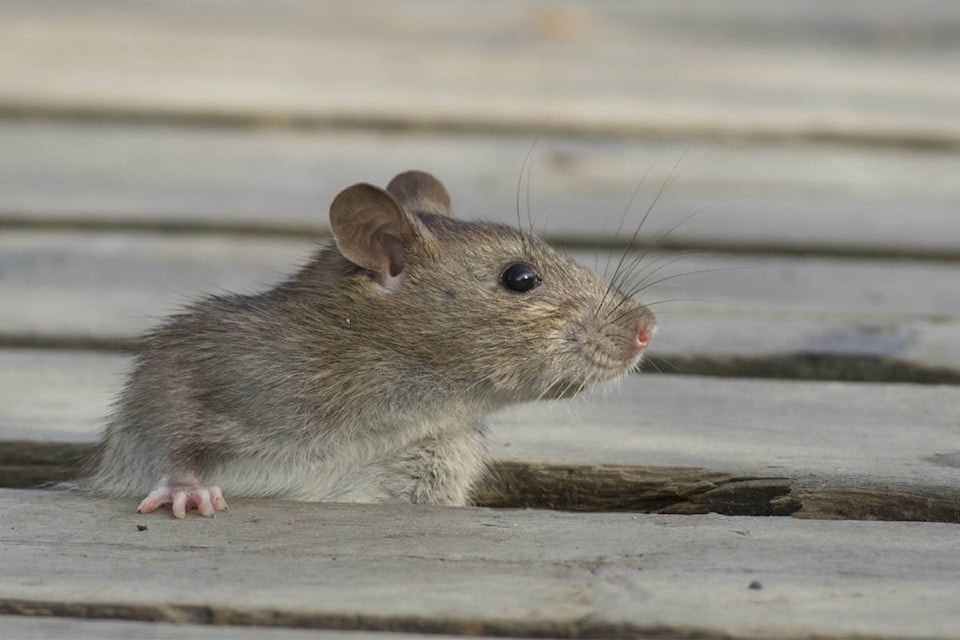Sadly, as most residents are aware of by now, Nelson has rats.
Nelson went from having no reports of rats in 2017 to now having regular reports in all three main areas of the city. Rats are prolific breeders that are capable of exponential growth. Rats, like all animals, have four habitat needs, including food, water, shelter and space. As they have found abundant sources of all four in Nelson, and other neighbouring Kootenay communities, there has been a surge in rat numbers.
Ratus ratus, or the roof or black rat, is a species introduced to North America and is the species found in Nelson. Knowing exactly how the roof rat colonizes new areas is difficult to determine, but they can take advantage of human transportation and hitch rides in automobiles, rail cars, and can arrive in deliveries of hay and other goods. They may even hitch a ride on someone’s daily commute between communities. Once a pregnant rat or a pair arrive in a new location, the growth begins.
In a year, two rats can become 1,000 and 1,000 becomes 500,000 by year two. As long as the resources are there in unlimited amounts and predators are few, rats will continue to proliferate. However, there are many effective ways to limit the rat population.
This starts by removing access to their habitat needs. Reports of rats in Nelson are often connected to backyard compost. Rats are seen near or even denning in unsecure compost. Garbage, fruit, bird seed, animal feed, and fruit and vegetable gardens all contribute as well. However, compost and garbage are the only attractants that are not seasonal. Most people keep garbage secure, mostly to avoid bear conflicts, but managing compost effectively can be an important strategy to reducing rats to manageable levels.
Whether you use a store-bought composter, or a homemade one, if you ensure it is secure and no opening larger than a quarter, then rats should move on to find food in another location. If you make your own composter, line it on all sides, top and bottom with hardware cloth. This is a fine wire mesh that can be bought at the hardware store.
Remember rats borrow and can squeeze through any opening bigger than a quarter or loonie, depending on the age of the rat. Turn your compost often and be sure to rake all the way to the bottom where rats may be nesting. Note that rats can chew through thin metal or plastic composters. You could also consider composting indoors by using mechanical, high heat compost machines or worm composting. Ensure all garbage and animal feed are kept indoors in secure containers with tight-fitting lids.
If you need to trap rats, use a quick kill trap. It has been anecdotally reported that the best bait tested is Nutella or similar chocolate hazelnut spreads. Set the bait deep inside the trap and rebait often. If you trap outside, don’t leave the trap set during the day, as it can catch birds and squirrels. Avoid the use of poisons as this can lead to non-target species such as owls, and other rat predators, getting seriously ill and many can die as a result. Many species can be help keep rats in check including barn owls and coyotes. However, the use of poisons can short-circuit these efforts.
Healthlink BC has information on trapping procedures and on the safe handling and disposal of the dead animal: https://www.healthlinkbc.ca/healthlinkbc-files/getting-rid-rodents
Most importantly, do not make your property hospitable to rats. Remove any cover and ensure all opening into buildings are well-sealed. Any leaky plumbing that provides water should be addressed. Keep your property free of food attractants and have discussions with your neighbours. Reducing rats in Nelson requires a community effort.
For more on WildSafeBC’s rat information, visit https://wildsafebc.com/rats/.
Rosie Wijenberg is Nelson’s WildSafeBC community co-ordinator.
